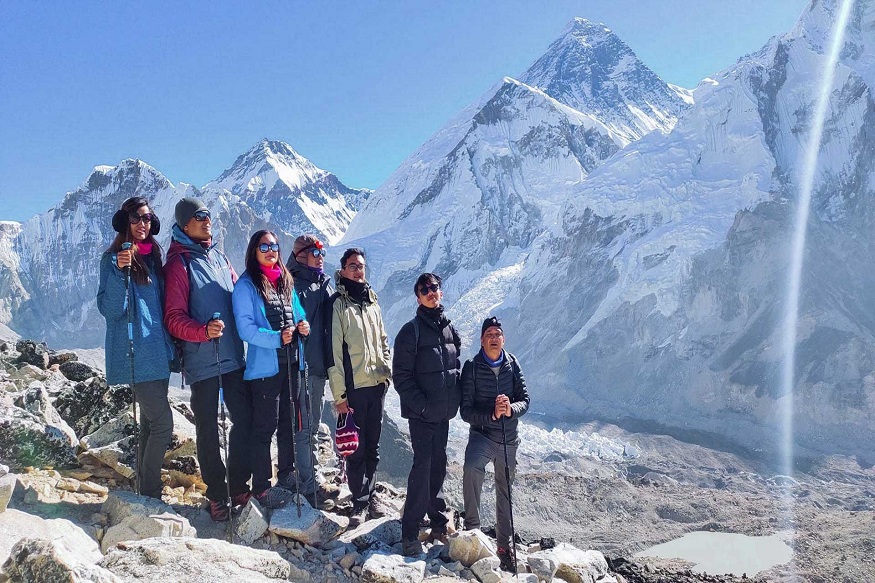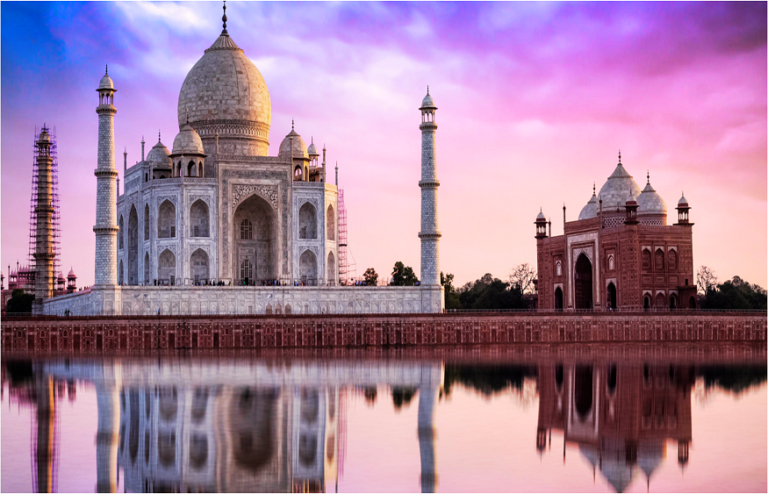
Reaching the base of the world’s highest mountain is not just a physical journey — it’s an emotional and cultural journey that lingers long after returning home. Embarking on the journey to Everest Base Camp is a cherished dream for many people, but doing so under the guidance of and with the support of Sherpas is a profound way to imbue the adventure with meaning and authenticity. Even just setting foot in the Khumbu region is enough to set the landscape in motion — and broaden your understanding of what it means to be walking among giants.
The expedition begins with a flight to the narrow airstrip at Lukla, which greets you with all the grandeur of entering the world of the Himalaya. By the end of this trek, each day along the way will take you further into a land of steep cliffs, rushing rivers, and aged stone villages close to the huge snow-capped mountains. But what makes this journey truly special are the Sherpa. These legendary mountaineers are not only your guides and porters; they are the keepers of their mountain home and the lifeblood of the trek itself.
Everest Base Camp Treks Sherpas bring the climb to life with stories of Everest, their deep connection to the land, and their unparalleled expertise in high-altitude trekking. They help you deal with the challenges posed by the terrain, altitude, and safety at every turn. They also immerse you in the spiritual element of the Himalayas in the process, taking you to centuries-old monasteries and other sacred sites, where colorful prayer flags flap in the wind and the sound of spinning prayer wheels vibrates through the air.
It’s a sense of accomplishment that increases as you get closer to the iconic site. You are now at the foot of the highest mountain on the planet, and you stand among glaciers and towering peaks, and it is, at once, humbling and soaring. The Sherpas lift the hike from a hike to a personal experience of awe as you scale this majestic valley.
About Everest Base Camp Trek
Certainly, here is the paragraph from above rewritten with a human writing style: This is one of the most popular trekking ventures in the world, which will provide you with The Everest Base Camp trek will take you through breathtaking views of the snow-capped peaks, glacial rivers, alpine forests, and traditional Sherpa villages. It usually lasts between 12 to 14 days and reaches its highest point in Everest Base Camp, at 5,364 meters (17,598 ft). Along the trek, they are rewarded with sweeping vistas of majestic peaks including Lhotse, Nuptse, Ama Dablam, and, naturally, Mount Everest itself. Winding through the heart of Sherpa country, the trail leads trekkers to ancient monasteries, prayer wheels, and lessons in Buddhist customs. Although it does take a good level of fitness and preparation, the Everest Base Camp Trek is achievable by many, combining natural wonder, cultural richness, and personal achievement for an incredible experience.
Why Trek with Sherpas?
When trekking with Sherpas, you’re not just on the Mount Everest base camp Trek — you’re being guided on an experience like no other. The Sherpa people are native to the Himalayan area, and they have generations of experience in terms of the mountains, weather, and terrain. Renowned in all parts of the world for their legendary strength and hospitality, and expertise in high altitudes, Sherpa guides add huge value to any trekking expedition. We will take care of your safety and comfort along the way, and share stories, culture, and spiritual insight from our connection to the Himalaya. So, in challenging environments such as trekking up high mountains, Sherpas are also trained as first responders and in altitude sickness prevention. By trekking with Sherpas, you are also supporting the local economy and encouraging responsible tourism. Knowing the trail, weather patterns, and hidden gems along the way, they ensure that you have the best possible time on your trek. Whether that’s pacing, Teahouse recommendations, or altitude acclimatization, a Sherpa guide allows your journey to be a more meaningful, safer, and impactful experience.
The Adventure Begins: Embarking on the Trail
When trekkers arrive at Lukla, they will take their first steps into the very heart of the Khumbu region. The first days of the trek are spent weaving through remote hamlets, including Phakding and Monjo, as trekkers are introduced to sweeping Sherpa culture and the pristine Dudh Koshi River valley. As the trail snakes past pine forests, suspension bridges, and prayer flag-draped paths, trekkers slowly climb toward the busy mountain town of Namche Bazaar, an important acclimatization waypoint. It is the time in your hike when you have a rush of thrills for both the unknown and the beautiful scenery as you prepare to depart from the. A pace of exhilaration and contemplation is the tone for the trek ahead, and it starts the minute you set foot on the trail between Lukla and Namche. This is when bonds with your fellow trekkers, guides, and porters, and the amazing experience of trekking to Everest Base Camp really begin.
Tread the Trail and the Stages to in Mind
The Everest Base Camp takes place entirely on a well-trodden trail through the Khumbu region of Nepal, with each leg providing its own unique challenges, highlights, and scenic wonders. Trekking from Lukla (2,860m), trekkers head to Phakding, and then onwards to Namche Bazaar (3,440m), the region’s largest Sherpa town and a key point for acclimatization. After stopping in Namche, the trail rises to Tengboche (3,867m), famous for its ancient monastery and panoramic views of Ama Dablam. After that, there’s the trek to Dingboche (4,410m), another important altitude acclimatization stop where many hikers spend a day resting or walking to nearby lookouts. The next legs — Lobuche (4,940m) and Gorak Shep (5,164m) — take trekkers into more rugged, more dramatic territory. The final ascent to Everest Base Camp (5,364m) from Gorak Shep is exhilarating and strenuous, with expansive views and a huge sense of achievement. Many also trek to Kala Patthar (5,545m) the next morning for the best views of Mount Everest at sunrise. The return trip follows the route back to Lukla, allowing trekkers to pass by familiar villages and relish the surroundings with a sense of accomplishment. Each one builds off the previous stage, gradually taking you deeper into the Himalayas, with time to acclimatize, reflect, and connect with the land and its people.
Dealing with altitude and acclimatization
Himalayan Base Camp Trek Acclimatization — the process of allowing your body to adjust to the diminishing levels of oxygen at higher altitudes — is of utmost importance on the Everest Base Camp Trek. While these peaks are exhilarating, their altitude is unforgiving, and the risk of altitude sickness increases after about 3,000 meters, so be sure to follow a well-paced itinerary with built-in acclimatization days. Common way stations include places like Namche Bazaar and Dingboche, where trekkers spend additional days acclimatizing. You don’t just sit around these days, instead, short hikes to nearby viewpoints stimulate the acclimatization process without overworking the body. But not everyone can acclimatize to altitude, and symptoms of altitude sickness include headaches, nausea, fatigue, and dizziness. Drinking plenty of water, eating well, and rising gradually all help reduce these effects. When you trek with Sherpa guides who are experienced, it offers an extra layer of safety as they can keep an eye on your health and modulate your pace accordingly. Descending is only safe if symptoms become severe. Many trekkers also bring medications, such as acetazolamide (Diamox), to use preventively. Acclimatizing properly not only increases your chance of reaching Everest Base Camp successfully but also makes for a more enjoyable experience. There are challenges, but by honoring your body’s capacity and giving your system time to acclimatize, you can surmount altitude challenges and immerse yourself in the majesty and adventure of the Himalayas.
A Cultural Stopover on the Way
The Everest Base camps more than just peaks and picturesque landscapes — it’s a cultural immersion in elemental Sherpa life, Tibetan Buddhist customs, and remote mountain living. Trekking through villages such as Namche Bazaar, Tengboche, and Pangboche, you will be met with the hospitality of the people, brightly colored prayer flags gently waving in the breeze, and ancient monasteries resonating with spiritual chants. Trekking, however, isn’t simply about the journey: Touring Tengboche Monastery, one of the most revered Buddhist sites in the area, provides a moment of serenity and culture along the way. Sherpa families frequently host trekkers in their teahouses, serving up hearty meals and some understanding of their lifestyle. The trail is unique, interspersed with yaks transporting goods, mani stones etched with prayers, and spinning prayer wheels. The local people really do make for some of the best moments, whether it be a story, a smile, or a new phrase learned. It lends Everest Base Camp Trek a dimension beyond mere physical adventure, rendering it a spiritual journey and human experience.
Sherpas and Trekking in the Himalayas
What is necessary to climb Mount Everest? Sherpas. They are the keystone to the Everest Base Camp trek and much more than many people think. World-famous mountaineer guides, Sherpas, are the essence of Himalayan expeditions. They are not simply guides or porters — they are cultural ambassadors, safety leaders, and morale boosters throughout the journey. With generations spent traversing the high-altitude landscape, Sherpas possess an unrivaled understanding of the trail, climate, and optimal acclimatization strategies, guaranteeing the safety and health of each trekker.
Their calm, confident presence both physically helps and emotionally reassures as the trek becomes more arduous with altitude. Whether it’s maintaining the pace, watching for symptoms of altitude sickness, preparing hot meals in a remote teahouse, or sharing local stories and traditions, their roles are what transformed a challenging journey into a transformative experience.
Everest Base Camp trek cost Sherpas act as an interlocutor between trekkers and the unique culture of the Himalayas. Through them, you learn about the spiritual significance of the same mountains, what prayer flags mean, and the customs of the remote villages you walk through. Their profound way of looking at nature and community creates a humility and appreciation that transfers well to the people they guide. Trekking with Sherpas is more than reaching a destination— it’s about traveling with the people who live in these mountains, and whose quiet strength and generosity are what make the Everest Base Camp trek so special.
Achieving this milestone: Reaching Everest base camp
The trek to Everest Base Camp is a day-long challenge that tests your mental and physical fortitude. After clambering up steep trails, crossing narrow suspension bridges, and traversing high-altitude passes, it feels otherworldly to finally set foot on the iconic rocky plains of base camp. It’s not simply a place; it’s a reward for every challenge you face getting there — aching legs, frigid mornings, thin air — all to arrive at one of the most iconic locations on Earth.
At 5,364 meters (17,598 feet), yes, Everest Base Camp isn’t about towering monuments or luxury amenities. Instead, it’s campy and scrappy, with snow-capped mountains, soaring icefalls, and prayer flags flapping in the high Himalayan breeze. There’s a subdued sense of pride in being there — an awareness that you’re at the foot of the world’s highest mountain. You’re not scaling Everest, but getting this far is a remarkable achievement.
Trek To Base Camp Mount Everest Sharing the moment with your group and the Sherpa guides who supported every step on the way makes the moment even more rewarding. There’s no energy quite like the one at the base camp — buzzing with camaraderie, celebration, and reflection. Most trekkers mark the experience with a photo at the rock that is the icon of base camp, but the real memory is found in the sense of triumph and humility. Getting to Everest Base Camp is definitely not a mere checklist item. It is a humbling reminder of your own strength and the magic in the mountains.
What to See at Everest Base Camp
It is not like some other trekking destination where you would come to reach Everest Base Camp. It’s days of gradual ascent, flanked by some of the tallest mountains on Earth, and the final approach to base camp winds over rocky glacial terrain, where the landscape is as much otherworldly as it is awe-inducing. Look for a dramatic, windswept expanse dotted with prayer flags, cairns, and expansive views of the Khumbu Icefall — the way in for climbers en route to Everest’s peak.
Although it may seem like a permanent location or a village (it’s often called base camp), it is simply a seasonal staging ground for climbers. During the three spring and autumn climbing seasons, you can witness colorful expedition tents sprawling across the glacier and teams of climbers getting ready for their ultimate ascent. If you’re hiking in those very busy months, however, there’s tangible energy in the air, with climbers, Sherpas, and trekkers all mixing together in common reverence of Everest.
You can’t actually see Everest’s summit from base camp — it’s behind the adjacent peaks — but you are surrounded by iconic goliaths such as Nuptse, Pumori, and the Khumbu Glacier. Temperatures can be chilly and conditions windy, so the right equipment is key to enjoying the moment comfortably.
You’ll spend only a brief period of time at base camp, then return to Gorakshep for the night. Most trekkers linger over the experience, taking photographs, maintaining a reverent silence, or simply absorbing the magnitude of nature’s awe. Base camp is not merely the end of a journey — it’s the emotional and symbolic climax of the whole trek.
Thoughts and Takeaways from the Journey
Trekking to Everest Base Camp is not just a physical challenge — it’s a journey of personal growth, cultural experience, and profound introspection. When you come down from the hill and reflect upon the journey, all the lessons learned on the ascent kick in. The trek is a lesson in resilience; it teaches you that you can get through long, hard days if you push through with both perseverance and patience. You learn to take it easy, to listen to your body, to honor nature’s rhythms, not to conquer them.
For many trekkers, one of their lasting impressions is the humility, strength, and kindness of the Sherpa people. They can be the kindest, most generous, and unwavering source of strength you have never heard 2]ed it before.)Even the hardest of them: Their warmth can be inscribed in you, urging you that greatness often comes in small, unassuming packages. The connection with the Sherpa guides and the local communities is something that you carry well beyond the trail, changing your perspective and view of the world and the people in it.”
The trekking also inspires gratitude—gratitude for health, for simplicity, for a hot meal at the end of a long day, for the company of fellow trekkers, and gratitude for the very privilege of walking among Earth’s highest mountains. There’s a revived appreciation for the fundamentals of life and a refined realization of what matters most.
“You’re different when you come back, you’re not the same.” You’ve had struggles and stood at the base of Everest and learned more than you ever imagined about perspective that will follow you. The hike to base camp doesn’t finish at the trailhead — it emboldens a lifetime of remembering and gives you an inner strength.
What is it like to hike to Everest Base Camp?
The Everest Base Camp Trek offers a once-in-a-lifetime expedition that brings together the aspects of physical activity, cultural exposure, and the majestic splendour of the Himalayas. The trip begins with a breathtaking flight into Lukla and is followed by a multiday trek through the Khumbu Valley. The daily changing terrain — from dense forests and swinging bridges over raging rivers to wide open alpine fields and views of glaciers.
The route passes through traditional Sherpa villages such as Namche Bazaar, Tengboche, and Dingboche, where you’ll be welcomed with warm hospitality, colorful prayer flags, and distant yak bells. As you climb higher, the landscape grows harsher, the air thinner, and the temperature colder. You walk for 5-8 hours a day, with regular days of rest and acclimatization included in the itinerary.
The work increases with elevation, but so does the reward. The main event here, of course, is arriving at Everest Base Camp itself — standing on the rocky glacial plains at the foot of the world’s tallest mountain. The sense of victory, spectacular views, and fellowship with co-hikers are all well worth the effort.
It is not merely a hike; it is a life-altering trek through one of the world’s most stunningly familiar terrains.
Why do people like to visit Everest Base Camp?
Everest Base Camp attracts thousands of trekkers annually, and it’s a draw that goes well beyond the bragging rights of making it one of the world’s most iconic destinations. For many, a trip to Everest Base Camp symbolizes personal achievement, resilience, and the spirit of adventure. It’s about where strength isn’t just physical or reaction time, but rather both are tested, and every step taken is closer toward something so extraordinary.
The Himalayas themselves are a big attraction. The trek provides stunning views of towering peaks such as Everest, Lhotse, Nuptse, and Ama Dablam. The shifting geography — forests and rivers, glacier fields and immense alpine valleys — is continuously awe-inspiring. And there is something profoundly humbling about walking in the shadows of such monumental natural beauty.
Another big reason that people come for this trek is to experience the Sherpa culture. Trekking along the way, trekkers stop at local teahouses, tour ancient monasteries, and learn local Buddhist traditions. This is something this cultural exchange adds to the journey — a profound, human element.
For many, the trek is also an opportunity to temporarily step away from the demands of daily life and reconnect with nature, themselves, and each other. Duh, Everest’s Base Camp has some sort of a meaningful and resonant experience, whether you’re seeking a broad, personal transformation, an adventure, or just to get away from the grind for a few weeks.
How to prepare to hike to Everest Base Camp?
How to Prepare for Everest Base Camp Trek: Tips and Plan. It is not a technical climb, but it is a physically demanding trek at high altitude that demands endurance, grit, and wise pacing. It is best to begin your training 8–12 weeks prior to the trek. Build cardiovascular endurance, leg strength, and core stability with hiking and running, stair climbing, and strength training.
It also helps to simulate trekking conditions — take long hikes with a heavy pack so that your body gets used to carrying equipment and walking over uneven terrain. Work on rest days in your training so that recovery becomes part of your routine, just as an acclimatization day would be in the actual trek.
In terms of gear, high-quality hiking boots/walking shoes are worth investing in, and should be broken in before you take on this trip. A good amount of layers, a solid backpack, a warm sleeping bag, and trekking poles are all necessary. Be prepared for different weather conditions, but pack less, particularly the cold weather higher up.
Prepare yourself mentally for long days, few amenities, and the discomfort of being out of your comfort zone. It is vitally important to understand altitude effects and recognize altitude symptoms. Travel insurance that includes evacuation coverage is essential.
Finally, go with a reputable company, such as Sherpa Expedition and Trekking, to manage logistics, guides, and permits. Becoming a successful and rewarding trekker to Everest Base Camp is within your reach with the right preparation.
How difficult is a trek to Everest Base Camp?
The Everest Base Camp trek is rated as moderately difficult, but it has some challenges that are specific to trekking in high-altitude, mixed terrain for a prolonged amount of time. There is no technical climbing per se, but trekkers must be ready for long days of walking (usually in the 5-to-8-hour range) over rocky trails, steep inclines, and high-altitude passes.
The biggest challenge is the altitude. At altitudes above 5,300 meters (17,500 feet), oxygen levels are nearly 50% lower than at sea level. That can make even simple tasks such as walking uphill or lacing up your boots seem more taxing. Acclimatization is key, which is why most plans have rest days in places such as Namche Bazaar and Dingboche.
The weather can complicate matters further. Nighttime temperatures can plummet, and weather can be unpredictable in the mountains. You must prepare for cold, wind, and even snow. And also, the accommodations are basic teahouses with shared rooms and few amenities, which may take some getting used to for some travelers.
In the right hands, this trek is well within the capabilities of a moderately fit person with careful planning and good support. Especially if you are trekking with experienced guides and porters, especially Sherpas, your comfort and safety level increases. With the proper mindset and an appropriate pace, the trek is a profoundly rewarding experience, demonstrating that you don’t have to be a mountaineer to walk in the shadow of the world’s tallest mountain.






